What Does The Camshaft Position Sensor Do

The camshaft position sensor (CMP), a seemingly simple component, plays a critical role in the internal combustion engine (ICE). Its primary function is to monitor the position of the camshaft, providing the engine control unit (ECU) with essential data for precise fuel injection and ignition timing. This information is fundamental for optimal engine performance, fuel efficiency, and emissions control. But as the automotive landscape undergoes a radical transformation, driven by electrification, hybridization, and intelligent systems, what becomes of the CMP? And how might its functionality evolve to serve the needs of future mobility solutions?
The CMP in a Shifting Landscape
While the CMP, in its traditional form, might appear less relevant in a purely electric vehicle (EV), its underlying principle – precisely monitoring rotational position – remains absolutely crucial. Consider the sophisticated electric motors driving EVs. These motors often employ sensors to determine rotor position, enabling precise torque control and maximizing efficiency. Although the technology differs (e.g., resolvers, encoders, or Hall effect sensors directly integrated into the motor), the core objective – accurately determining rotational position – is fundamentally the same as that of a CMP in an ICE. The challenges, however, shift from simply timing fuel injection to optimizing motor performance across a wide range of speeds and loads.
Hybrid vehicles, bridging the gap between ICEs and EVs, present a more complex scenario. In parallel hybrid systems, where both the ICE and electric motor can drive the wheels, the CMP retains its traditional function for the combustion engine. However, its role becomes integrated with the electric motor's position sensors to enable seamless transitions between electric-only, ICE-only, and combined operation. The ECU must intelligently manage both power sources, requiring precise synchronization and coordination based on sensor data from both systems. This demands more sophisticated sensor integration and signal processing techniques.
Beyond the Traditional: Smart Sensing for Tomorrow's Mobility
The future of the CMP, or rather its functional equivalent, lies in smart sensing solutions. We are moving towards a world of autonomous driving, advanced driver-assistance systems (ADAS), and vehicle-to-everything (V2X) communication. These technologies rely on a dense network of sensors, including cameras, lidar, radar, and ultrasonic sensors, to perceive the environment and make intelligent decisions. However, the internal workings of the vehicle itself also need to be smart and self-aware.
Imagine a future where the “CMP” is no longer a discrete sensor but rather a component of an integrated powertrain monitoring system. This system would not only track camshaft position but also monitor crankshaft position, piston movement, valve timing, and even engine temperature and vibration. Advanced algorithms would analyze this data in real-time, predicting potential failures, optimizing engine performance, and even adapting to changing driving conditions. In EVs, this same concept applies to the motor and battery pack. Imagine a system that monitors the rotor position, temperature gradients within the battery, and even the condition of the power electronics, predicting potential failures and optimizing charging strategies.
This shift towards smart sensing presents both opportunities and challenges. One of the biggest challenges is data processing. The sheer volume of data generated by these sensors will require powerful onboard processing capabilities and efficient communication protocols. Furthermore, ensuring the reliability and accuracy of these sensors is paramount, especially in safety-critical applications. Redundancy, self-diagnostics, and advanced signal processing techniques will be essential to mitigate the risk of sensor failures.
The Path Forward: Integration, Intelligence, and Optimization
The key to unlocking the full potential of smart sensing lies in seamless integration. Sensors must be tightly integrated with the ECU and other vehicle systems, enabling real-time data exchange and coordinated control. Furthermore, artificial intelligence (AI) and machine learning (ML) will play a critical role in analyzing sensor data, identifying patterns, and making intelligent decisions. For example, AI algorithms could learn the optimal valve timing for different driving conditions, maximizing fuel efficiency and reducing emissions. In EVs, AI could predict battery degradation and optimize charging strategies to extend battery life.
However, we must acknowledge the realistic challenges ahead. Developing reliable and robust AI algorithms requires vast amounts of training data and significant computational resources. Furthermore, ensuring the security of these systems is paramount, as vulnerabilities could be exploited by malicious actors. The automotive industry must invest in cybersecurity research and develop robust security protocols to protect these critical systems.
Ultimately, the future of the CMP, or its evolved counterpart, is inextricably linked to the future of mobility. As vehicles become more intelligent, connected, and electrified, the role of sensing technology will become even more critical. By embracing innovation, investing in research, and addressing the challenges head-on, we can unlock the full potential of smart sensing and create a future where mobility is safer, more efficient, and more sustainable. The journey from a simple camshaft position sensor to a comprehensive, intelligent powertrain monitoring system represents a significant leap forward, paving the way for a truly transformative automotive experience.
Imagine a world where vehicles proactively adapt to our needs, optimizing performance, predicting maintenance, and ensuring our safety and comfort. This future is within reach, driven by the power of intelligent sensing and the relentless pursuit of innovation. The "CMP" of tomorrow is not just a sensor; it's a key enabler of a more connected, intelligent, and sustainable future for mobility. This future is not just about getting from point A to point B; it's about the journey itself.
